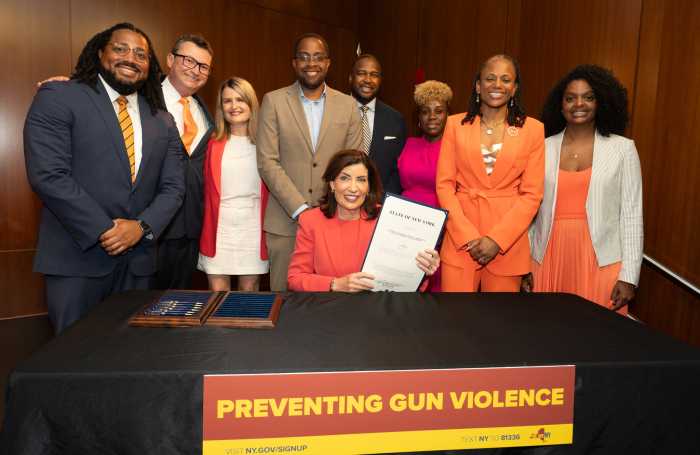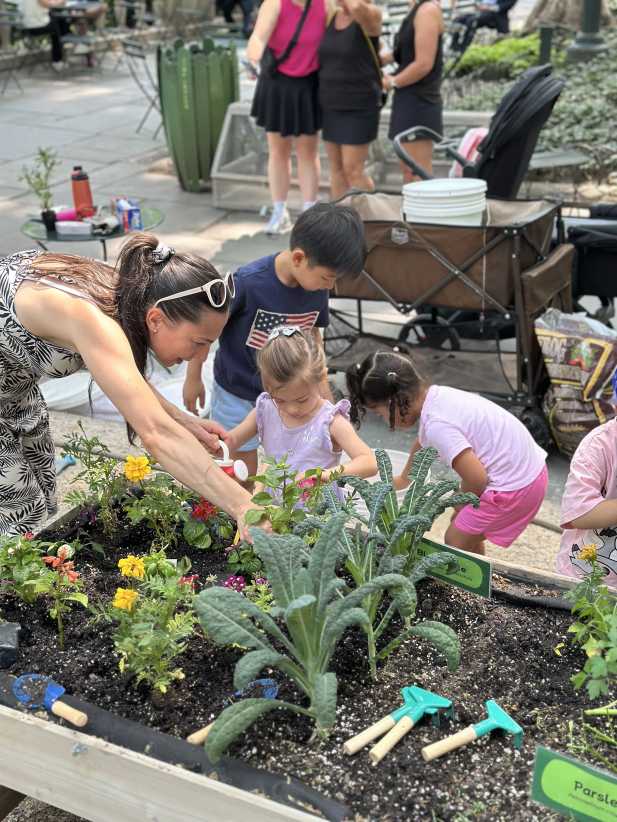Stores with names like Jamaica Hatland, Sportsworld and 4Season Pawan Cap and Hat Store line the busy urban plaza that downtown Jamaica locals call the Coliseum Block.
Shops selling jewelry and electronics spill out onto the bustling pedestrian lane, joined by merchants selling t-shirts and purses. And hats.
Hats fill the Coliseum. They bounce down the block, cocked slightly to the side, or straight on the heads of those who wear them, brims as even as an arrow, their fresh-off-the-shelf decals glinting in the afternoon sun.
Gangs also figure prominently in the Coliseum and its environs. Two police officers on duty outside the mall on a recent afternoon said blue and red bandanas - worn hanging out of a back pocket to represent the Crips and the Bloods gangs, respectively - are ubiquitous in this part of town.
Until around a year ago, many of the hat shops in and around the Coliseum and many others throughout New York City were selling baseball caps patterned to look like bandanas favored by the Bloods and the Crips, in addition to models bearing the logos of other gangs like the Latin Kings. These were not knock-offs. They came by the truckload, emblazoned with the logo of big-name apparel manufacturer New Era - the exclusive supplier of hats to Major League Baseball - delivered to cities across the country.
Exposed by the news media in August 2007 and facing a subsequent political backlash, New Era claimed ignorance, but agreed to remove its “gang-themed” merchandise from store shelves. In March 2008, however, an investigation led by the Brooklyn District Attorney’s office found stores throughout the city still carrying the apparel.
The problem, say Councilmembers Leroy Comrie and Peter Vallone, Jr., who led an October 20 joint oversight hearing to revisit the sale of gang paraphernalia, is two-fold. On the one hand, stylized merchandise might appear to condone gang activity to those already involved and legitimize it in the minds of vulnerable youngsters on the cusp. On the other, innocent people might purchase the apparel, unaware of the dangerous subtext of a royal crown or a five-pointed star.
One of the employees at a hat shop on the Coliseum Block agreed.
“They shouldn’t be allowed to sell them [gang-themed hats] because there’s a lot of gangs in this area - Bloods, Crips - and that’s no good,” said the man, who claimed the manufacturer of the gang-related hats issued a recall about a year ago.
“Half the people didn’t know [what the hats represented]. The others, well, they knew. You know the gang bangers when they come in,” he said.
A few storefronts away, aficionados pored over fitted hats in shades of every color in the spectrum. There were some eye-catching designs, too, but none overtly gang-related.
An employee said all of the “big stores” that have accounts with the major hat manufacturers no longer stock gang-themed caps, but noted the caps “were selling good” while on the store’s shelves.
Comrie, who heads the Council’s Committee on Consumer Affairs, said the products have moved from larger to smaller shops and primarily to illegal vendors.
“Now, we’re seeing a lot of secondary companies that have started selling this merchandise - new players and new business people,” he said.
In the absence of legislation and prosecution, made nearly impossible by the First Amendment, the most effective means of change is education - speaking with parent and community groups about the dangers of gang-themed clothing, Vallone’s office said.
Comrie added that he and fellow Councilmembers are hoping to collaborate with local business associations to apply even more pressure to manufacturers and merchants - to put an end to what Vallone, the chair of the Committee on Public Safety, considers the exploitation of “a culture of violence and death for their personal profit.”
“The industry is still flourishing, they’re still making new items, they’re still making other things that are not healthy,” Comrie said, noting that a new Council investigation uncovered gang-related apparel across the city from midtown Manhattan, to Flatbush Avenue in Brooklyn, to Jamaica Avenue in Queens.
In fact, of all the cap dealers surveyed in the vicinity of the Coliseum, only one sold any seemingly gang-related goods: a small closet-sized shop on Jamaica Avenue selling doo-rags, cell-phone chargers - and hats.
The proprietor, whose chair in the shop entrance was nearly as wide as the shop, said he bought much of his merchandise wholesale - Yankees hats with vertical stripes, horizontal stripes; hats covered with little “NY” logos, and hats with bandana print - on 28th Street in Manhattan’s Garment District.
Stuck to a $10 blue bandana hat perched high on a shelf was a shiny New Era decal with the slogan, “It’s not a cap, it’s a flag.”
According to Comrie and Vallone, the fact that a hat has become a banner conveying a violent message is just the problem. It is one thing for New Yorkers to show off their admiration for the Mets, the Yankees - or even the Red Sox. But flaunting a gang affiliation, whether voluntarily or involuntarily, is a whole new ballgame, and a wildcard at that.






























